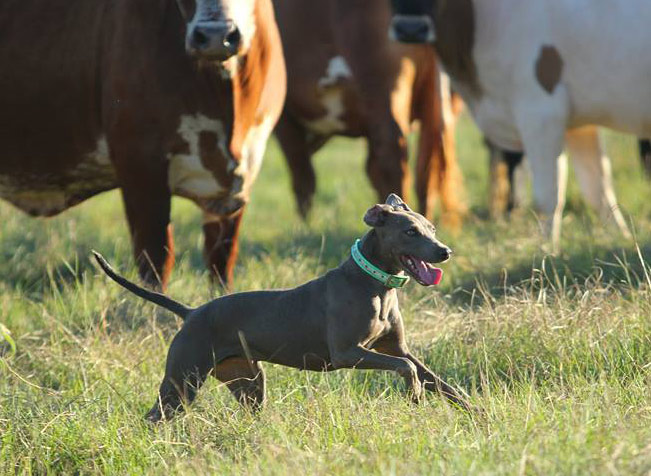| |
|
The Official Lacy Dog Standard |
| |
General Appearance
The Lacy is a medium-sized dog with a light, balanced yet powerful build. Correct Lacy movement alludes to great speed, strength and dexterity. The body is square with a level back and deep chest that extends into well-sprung ribs.
The front shoulders should be well laid back and muscular while the haunches have a tight, slightly rounded croup. Their legs are straight and medium in length with firm, cat-like feet. Dogs should appear more masculine than bitches. The coat is short and close fitting. Lacys should be evaluated as a working dog, and exaggerations or faults should be penalized in proportion to how much they interfere with the dog's ability to work. Scars should neither be penalized nor regarded as proof of a dog's working abilities.
Characteristics
Intelligent, intense, active and always alert. Originally created to be hog dogs, the Lacy was developed into an all-around working breed for ranchers, cowboys, hunters and trappers. Accordingly they display incredible drive and determination to work. Bold and tough with tremendous heart, they have enough grit to stop big game and control difficult livestock. They should be silent on track but loud and brave at the bay. They are easily handled and trained, should show great confidence in their owner, but are naturally territorial and may be wary of strangers. Though they make excellent companions, these dogs require a job for proper physical and mental stimulation. |
 |
Head
The head is medium in size. Powerful, keen and carried with pride.
Skull – Moderately long, medium in width and well built. Slight median line extending back over the forehead with a moderate stop at the foreface.
Muzzle – Of equal length or slightly shorter than skull when viewed in profile. Foreface should be moderately tapered but not dished, disproportionately short, or overly houndish or bully in appearance.
Jaws – Strong with even white teeth meeting in a correct scissor bite. Lips cover the jaws completely but are neither loose nor drooping.
Ears – Drop and rose ears are acceptable ear types as long as they are medium in length, thin, generally triangular in shape with a slightly rounded tip and hanging with a tight construction. While alert yet relaxed,the top of the ear should sit level with the top of the head. When held flat against the cheek parallel to the muzzle, the tip of the ear should align approximately with the inside corner of the eye. Excessively long ears measuring more than 1/4 inch past the inside corner of the eye are a fault. Ears should not be erect or cropped. Pricked ears and hound type ears are a disqualifying fault.
Eyes – Sharp, alert, and bright. Similar to a wolf in appearance and intensity. Colors range from bright yellow to rich brown. Should be round and set well apart.
Neck
The neck is slightly arched, strong, very well muscled, and of moderate length. Set well into the shoulders.
Forequarters
The forequarters should be muscular without excessive bulkiness. Shoulders should be well laid back and muscular. Legs are straight and medium in length.
Body
Strong, balanced, built for speed, agility, and endurance. Body should be square or just slightly longer than tall. Back should be well-muscled, level, and of moderate length. Deep, moderately broad chest extends approximately to the elbows. Combines with well-sprung ribs to provide plenty of lung space. Abdomen should be small, narrow and moderately tucked-up at the loins.
Hindquarters
Haunches should be balanced and muscular with a tight, slightly rounded croup. Proportionately angulated stifles lead to straight, low hocks.
Feet
Cat-like feet are firm, compact, and arched with webbed toes and thick pads.
Tail
Tail is medium set, reaching approximately to the hocks, and should be carried showing confidence.
Coat
Coat should be short, smooth, and tight with course guard hairs. Very little or no undercoat. Hair forming a ridge on back of neck and/or along spine is a fault. Excessively long or rough coat is a disqualifying fault.
Color
Though they are often called blue Lacys, there are three permissible color varieties. Blues are any shade of gray from light silver to dark charcoal. Reds range from light cream to rust. Tri colored lacys are blue with red points. Red may appear above the eyes, on the sides of the muzzle extending to the cheeks, front of the chest, on the lower legs and underneath the tail. A melanistic mask on otherwise acceptable colors is also acceptable but less desirable. White may appear on the brisket and may stretch from chin to groin. White may also be present on one or more paws. Excessive white is discouraged and markings on the face or above mid-line are a disqualifying fault.
Height and Weight
Lightly built but proportionally balanced within height-to-weight ratio. Height at the withers should be between 17 and 22 inches. Dependent on height and working condition, weight should be approximately 30 to 45 pounds for females and 35 to 50 pounds for males.
Gait
Effortless, nimble, and quick. Their gait is light and free but still powerful. All movement should allude to reserves of strength and dexterity.
Disqualifications
Unilateral or bilateral cryptorchid. Extreme aggressiveness or shyness. Incorrect white markings. Colors besides blue, red and tri. Dogs measuring under 17 inches or over 22 inches at the withers. Overshot or undershot bite. Pricked or hound ears.
|
| |
|
|
|
|







